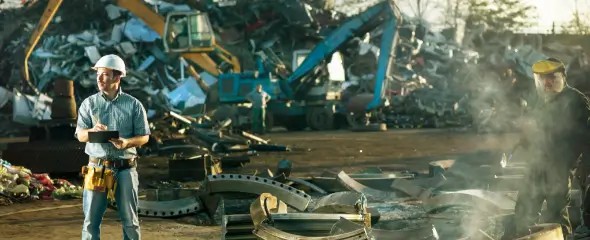In this day and age where everyone is “going green”, the act of recycling scrap metals is a popular choice not only for its energy and materials saving capabilities but its lucrative possibilities as well. Let’s find out more about recycling scrap metals.
Metal Recycling
Since metal working’s early days, scrap metal has gone through salvaging and reuse. From both an economical and environmental standpoint, it is extremely effective to recycle metal. Because, with repeated melting and casting, the properties of the metal itself do not deteriorate, metals like copper, aluminum, iron, and steel can be recycled over and over again.
Why Recycle Metals?
Why is a specialty like the retrieval of metal from seemingly scrapped or garbage objects something that the metal recycling industry wanted to do in the first place? One big benefit is that landfills won’t be filled with discarded scrap metal. On the contrary, in fact, these once discarded metals are now used to create new products, after being converted into raw materials.
As an example of just what kind of coefficient, sustainable source of raw materials can be provided by recycling… without the use of recycled materials, the price of casting would increase by approximately 20 to 40%!
Types of Scrap Metal
The scrap metal industry refers to its scrap in several ways. These include the following:
- Obsolete scrap
- Prompt scrap
- Home scrap
Metals Must Be Separated
Iron is contained in ferrous metals including gray iron, malleable iron, steel, etc. Using an electromagnet, nonferrous materials are separated from ferrous materials. This type of scrap is frequently used in cast steel and cast-iron products made by foundries and in steelworks.
Nonferrous metals do not contain iron. They are corrosion resistant, nonmagnetic, and, when compared to nonmetallic metals, are heavier. To separate nonmetallic pieces away from a large collection of scrap, a powerful cyclone or vacuum and metallic drum are used. To further separate problematic items out, “handpicking” by humans is required.
Purification and Refinement
A secondary refining is still needed even after separation. Certain specifications must be met before scrap can become usable raw material. Purification must be done.
To accomplish the refining process, pieces of scrap that have properties that are similar are heated to their melting point. Waste matter (or slag) is separated. For desired quality standards, even further refinement will still be needed.
Manufacturing
For use in foundries and mills, scrap metal is shipped throughout the world. Every year, worldwide scrap metal consumption ends up being in the hundreds of millions of tons.
Ferrous metal casters alone use their internal scrap for between 30 to 50% of their metal needs. Additional outside scrap sources account for approximately 40 to 50% of their needs.
In the steelmaking industry, thanks to the recycling of scrap metal, landfills have been spared some 235 million tons of waste. (This was reported by the Bureau of International Recycling in 2016.) Rather than using iron ore to produce steel, 56% less energy is required when recycling steel.
Your Recycling Experts
H&C Metals specializes in the recycling of metals including both ferrous and nonferrous metals, plus select computer scrap, and electronic scrap. For over 40 years, we have been experts in our field while providing the tri-state and Newark, New Jersey areas with stellar service. If you have questions about possible recyclable materials, our competitive prices, H&Cs’ Trucking and Hauling capabilities, or specific inquiries about metal recyclables, contact one of our knowledgeable customer service representatives today.
And be sure to check out our video about nonferrous materials!


